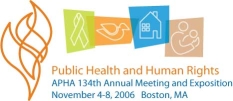 Back to Annual Meeting
|

|
 Back to Annual Meeting
|
APHA Scientific Session and Event Listing |
 Back to Annual Meeting
|

|
 Back to Annual Meeting
|
APHA Scientific Session and Event Listing |
Mary Elizabeth O'Neil, MPH, Karin A. Mack, PhD, and Julie Gilchrist, MD. Division of Unintentional Injury Prevention, CDC Injury Center, 4770 Buford Hwy NE K63, Atlanta, GA 30341, 770.488.1351, MONeil@cdc.gov
PURPOSE
Venomous and nonvenomous snakes reside throughout the United States. The last national survey of venomous snake bites was conducted in 1958-1959. National estimates of snake bites treated in emergency departments (EDs) are presented along with characteristics of the affected population, whether the snake was identified as venomous, and disposition at ED discharge.
METHODS
Snake bite injuries were abstracted from NEISS-AIP 2001-2003 data. Variables included age, sex, body part affected, disposition, and month of visit. When available, location and intentionality of the interaction and snake species were coded. Injuries sustained at work or during active military duty were excluded. Estimates are weighted and analyzed with SUDAAN.
RESULTS
Annually, an estimated 9,194 snake bites were treated in U.S. EDs. Males were more frequently seen in the ED for snake bites than females. Body extremities (hands/arms, legs/feet) were most often affected. Approximately 30% of patients were bitten by venomous species. Most patients (67.2%) were treated and released from the hospital (95% CI=61.7%-72.3%); however, only 34.7% of patients with venomous bites were treated and released (95% CI: 25.6%-44.9%).
CONCLUSIONS
Of the estimated 9,194 snake bites injuries treated annually, more than 2,700 persons were treated for venomous snake bites in U.S. EDs. Findings likely underestimate snake bites sustained because many are managed outside of an ED or are not treated. Primary prevention is encouraged. Prompt and appropriate first aid can limit or prevent additional morbidity from venomous bites.
Learning Objectives: After attending this session, participants will be able to
Keywords: Injury, Surveillance
Presenting author's disclosure statement:
Not Answered
The 134th Annual Meeting & Exposition (November 4-8, 2006) of APHA